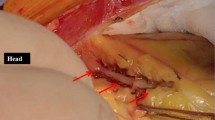Summary
Patients who have undergone coronary artery bypass grafting may develop acute myocardial infarction late after surgery. It is not exactly known in these patients whether acute infarction is predominantly caused by occlusion of bypass or native vessels. Also, there is no systematic and prospective data available with respect to an invasive, revascularizing therapeutic approach. Therefore, acute coronary angiograms were obtained in 21 consecutive patients with acute infarctions and remote bypass grafting to elucidate mechanisms causing myocardial infarction in these patients, and to assess results of catheter-based recanalization.
Infarction was causes by acute graft occlusion in 12/21 patients. Fibrinolysis and/or PTCA of grafts was successful in 6/8 attempts, direct PTCA of a native vessel was effective in 1/2 patients, 1 patient underwent emergency re-CABG, and another patient was treated noninvasively. Occlusion of native, ungrafted vessel caused infarction in 9 patients. Direct PTCA of native vessels was effective in 6/7 of those patients, 1 patient had re-CABG, and another patients was treated non-invasively. Together, catheter-based recanalization was obtained in 13/17 attempts. Thirty-day and 1 year mortality (after discharge) was 5% (1/21 patients) and 12%, respectively. Predischarge ejection fraction was 46%.
In conclusion, acute occlusion of bypass grafts is responsible for about half of all cases of myocardial infarction in patients late after surgery. Direct angiography and individually tailored catheter-based recanalization in patients with acute myocardial infarction late after surgery yield promising results.
Zusammenfassung
Bei Patienten mit operativer Myokardrevaskularisation kann es spät postoperativ (erneut) zu einem Myokardinfarkt kommen. Ob es dabei vorwiegend zum Bypass- oder Nativgefäßverschluß kommt, ist bei diesen Patienten nicht genau bekannt. Über angiographische Untersuchungen hierzu und/oder systematische direkte, kathetergestützte Rekanalisationsversuche wurde bei diesen Patienten bisher nicht berichtet. Wir fertigten deshalb bei einer konsekutiven Gruppe von 21 Patienten mit akutem Myokardinfarkt und stattgehabter aortokoronarer Bypassoperation akute Koronarangiogramme an. Ziel der Untersuchung war einerseits die Analyse der vorherrschenden Infarktursache bei operierten Patienten und anderseits die Steuerung einer individuellen Rekanalisationsstrategie bei diesen Patienten.
Bei 12/21 Patienten wurde der Infarkt am ehesten durch einen akuten Bypassverschluß hervorgerufen. Eine intrakoronare Fibrinolyse und/oder direkte PTCA von Bypassgefäßen war erfolgreich bei 6/8 Patienten, von Nativgefäßen bei 1/2 Patienten, und bei jeweils 1 Patienten wurde eine sofortige, erneute Bypassoperation durchgeführt bzw. konservativ behandelt. Bei 9/21 Patienten war der Infarkt durch einen Verschluß eines ungeschützten Nativgefäßes verursacht. Die direkte PTCA dieser Nativgefäße war bei 6/7 Patienten erfolgreich, bei ebenfalls jeweils 1 Patienten wurde eine sofortige, erneute Bypassoperation durchgeführt bzw. konservativ behandelt. Insgesamt war ein kathetergestützter Rekanalisationsversuch bei 13/17 Patienten erfolgreich. Die 30-Tage- bzw. 1-Jahres-Mortalität nach Entlassung war 5% (1/21 Patienten) bzw. 12%. Die linksventrikuläre Auswurffraktion betrug 46% vor Entlassung.
Zusammenfassend sind bei operierten Patienten der akute Bypass-Verschluß und der Verschluß einerr nativen, nicht bypassgeschützten Koronararterie zu je etwa der Hälfte Ursache akuter Myokardinfarkte. Bei invasivem, individuell angepaßtem, rekanalisierendem Vorgehen scheint die Hospitalmortalität dieser Patienten niedrig zu sein.
Similar content being viewed by others
Author information
Authors and Affiliations
Additional information
Eingegangen: 30. November 1998, Akzeptiert: 21. Mai 1999
Rights and permissions
About this article
Cite this article
Waldecker, B., Waas, W., Haberbosch, W. et al. Akuter Myokardinfarkt spät nach aortokoronarer Bypassoperation: Angiographische Befunde und klinische Ergebnisse eines invasiven Vorgehens. Z Kardiol 88, 868–874 (1999). https://doi.org/10.1007/s003920050363
Issue Date:
DOI: https://doi.org/10.1007/s003920050363




